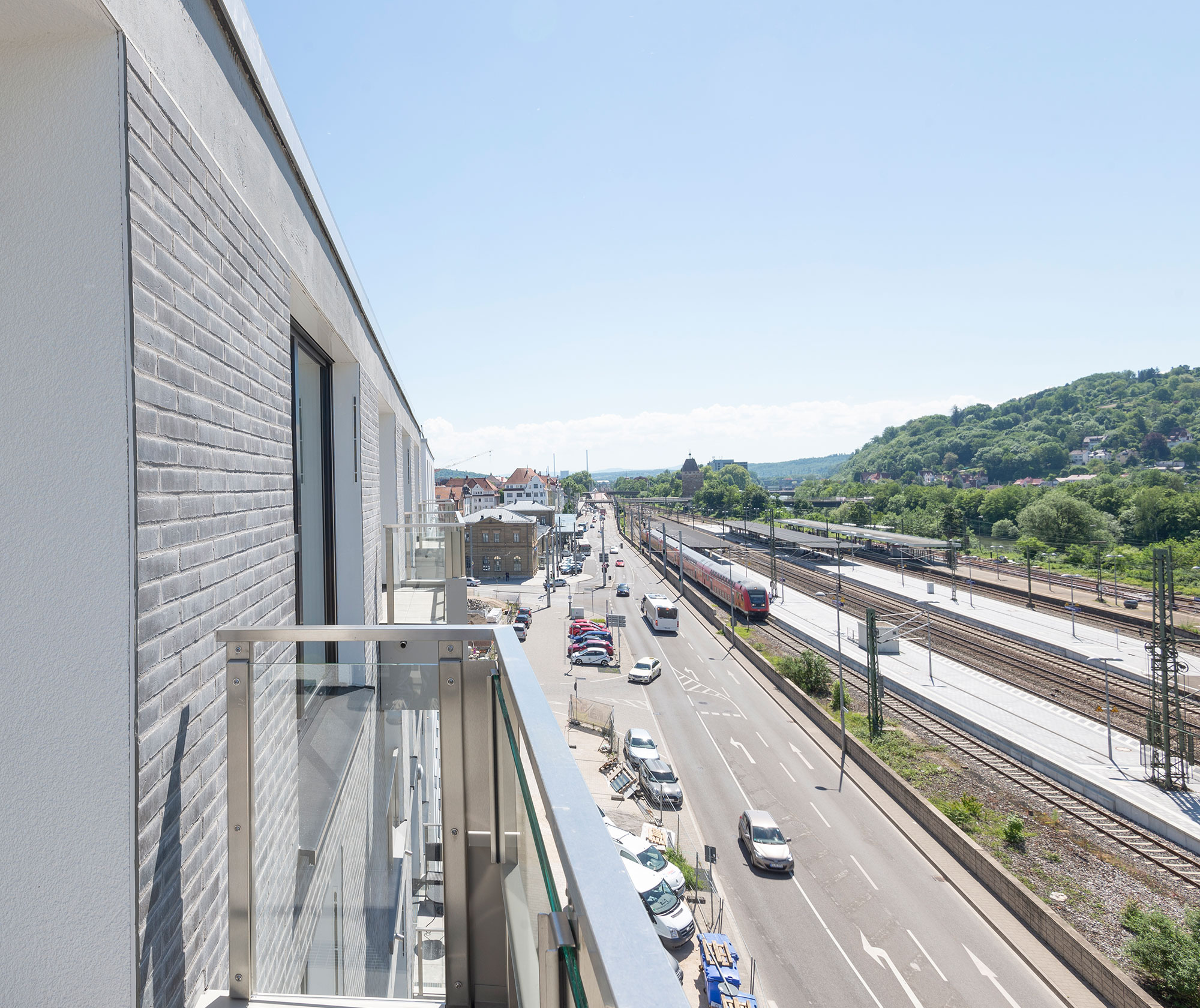Energy Supply in the Neighborhood
Trend-setting and efficient
The core of the technologically innovative urban district is the energy supply concept. This follows a sustainable approach that focuses on the connection of the electricity-, heating-, cooling- and mobility sector at local level. To this end, a central supply infrastructure with an energy center is to be built in the center of the district. Surplus renewable power from the local photovoltaic systems and from supra-regional generation will be converted into “green hydrogen” by electrolysis. The hydrogen will be stored and can be initially provided according to demand. The heat generated during the electrolysis process will also contribute to the supply of the neighborhood.

Univ. Prof. Dr.-Ing. Manfred Norbert Fisch
Scientific project management, Steinbeis-Innovation Center energyplus
Future starts in Esslingen
The energy supply of the neighborhood should cause almost no climate-damaging emissions such as CO2. Also, energy consumption should be reduced without loss of comfort.

Energy-optimized Buildings
The multi-story buildings in the individual blocks are constructed with special consideration of energy efficiency and economy: High-quality thermal insulation of the buildings provides the basis for low energy consumption and high living comfort. The roof areas are consistently used for generating electricity using photovoltaics. The buildings are supplied with regenerative heat via innovative systems. This allows the most ecological energy supply at building level.
Supply Structure
In Blocks Béla and Citadis, heat is supplied decentrally from a separate technical center. In each of these blocks, a biomethane cogeneration unit generates most of the heat. A gas peak-load boiler is only used to cover peak demand. The electricity generated by the cogeneration units and the photovoltaic roof systems is primarily used to supply tenants’ electricity, charged into an electricity storage tank for later use or is fed into the power grid. A central supply infrastructure is being set up in the neighborhood to supply energy to Block Desiro, E and the new building of the University of Applied Sciences of Esslingen.


Energy Center
An energy center is to be built as an underground structure in the center of the “New West Town” due to urban planning requirements. The centerpiece of the energy center will be an electrolyser that converts surplus electricity from renewables into hydrogen and thus makes the energy storable. The electricity required comes from local photovoltaic systems in Blocks Desiro, E and the university, as well as from external generation plants that supply clean energy via the public grid. This type of energy supply is considered an important component along the way towards a purely renewable energy system in Germany.
Increasing the Efficiency of Electrolysis
This unique approach has resulted in a significant increase in the efficiency of the electrolysis operation. In addition to the goal of a high level of self-provision using renewable energies, the heat loss generated during the electrolysis process will be used to increase overall efficiency. As a result, the degree of efficiency can be increased from around 55 – 60 percent to 80 – 85 percent. The heat loss is fed into a local heating network, via which Blocks Desiro, E and the university building are supplied from. This infrastructure covers the demand for heating and hot water for the buildings and, in summer, provides cooling energy by integrating adsorption refrigeration systems.
Electrolysis Process
With alkaline electrolysis, water is separated into its basic components hydrogen and oxygen by an electrochemical process. The size of the electrolyzer is 1 MWel. With about 4,500 hours of full use and a system-suitable mode of operation, the electrolyser produces about 2,800 MWh of hydrogen per year (Ø 250 kg/d, approx. 85 t/a). Around 600 MWh/a of usable heat loss from the electrolysis process is then available to supply Block Desiro, E and the university. For the year-round full supply of heat, the energy center is being further equipped with a heat pump (200 kWth), a bivalent cogeneration unit (natural gas 300 kWth, H2 138 kWth) and a gas peak load boiler.

Hydrogen in Numbers - What is lots, what is little?

Hydrogen is the energy carrier with the highest energy density of 33.33 kWh/kg.
The Climate District Neue Weststadt produces 85 tons of hydrogen per year. This annual hydrogen production from the Climate District corresponds to…

…the annual electricity consumption of 726 three-person households
(= 2,833,050 kWh/a)

… 283,305 liters of oil.

…a 212-fold circumnavigation of the earth by car. One kilogram of hydrogen makes a car drive about 100 kilometers.

Cross-linking and Energy Management
In the context of a “smart grid”, the connection of the supply systems is to be implemented with a comprehensive digital information network and energy management system (EMS). The primary goal of the EMS is to increase self-provision of local renewable energy while interacting with the upstream power grid in an energy-efficient manner. At the same time, CO2 emissions shall be minimized and an economical operation of the overall system shall be guaranteed.
A central energy management system regulates the energy flow. The research project will develop new solutions for the technical and legal challenges of decentralized energy marketing and develop applicable options for the future energy market. The aim is to test a highly automated, data-secure and transparent handling of marketing processes on the microgrid level directly in the field.

Tobias Nusser, M.Sc.
Steinbeis-Innovation Center energyplus

Sector Linking and Power Storage
The efficient and ecological connection of the sectors heat, electricity, mobility and industry is achieved by physically linking the individual components. The heat supply of Blocks Desiro, E and the university from the energy center is provided by a separately constructed local heating network, which is fed with heat from P2G and P2H systems (electrolysis and heat pump), among other sources.
Central electricity storage facilities serve to compensate for short-term deviations between renewable generation and energy requirements in the building or neighborhood electricity network. If required, they can also be used to stabilize the power grid. For example, the battery storage units are used to provide the necessary charging capacity for electric mobility at all times.
Hydrogen Utilization
The regeneratively produced “green” hydrogen is distributed via local and regional marketing channels. This way, the use of heat, electricity, mobility and industry are decoupled in terms of time and section.

"Power to Gas to Power"
A small part of the green hydrogen produced is directly utilised in the energy center. If electricity and heat are needed in the buildings in times when there is not enough photovoltaic electricity from the neighborhood, the hydrogen can be quickly and easily converted back into electricity in the energy center using the bivalent combined heat and power plant (H2 and natural gas) (P2G2P).
Green Hydrogen
In order to supply the “green” hydrogen for use outside the district, a feed-in station to the natural gas network as well as an H2 filling station are built in the “Neue Weststadt” on the former site of the Esslingen municipal utility. In the first stage of expansion, the hydrogen will be transported via an H2 pipeline from the energy center to the gas grid feed-in station and H2 filling station. Most of the hydrogen (100-400 kg/d) is to be loaded into trailers with tube bundle storage via the filling station and transported by trucks to customers in the industrial or public transport sector.

Mobility
A sustainable mobility concept will be integrated into the supply concept of the “Neue Weststadt”. The linkage of the energy supply concept with the mobility area is of particular importance in the context of long-term and sustainable urban development – extending beyond the district.
H2-Filling Station
In the second stage of expansion, an H2 filling station will be used to refuel individual vehicles. The refuelling of cars requires a pressure level of 750 bar on the vehicle side. Potential customers include fuel cell vehicles from private individuals, fleet operators (e.g. mobility sharing providers, municipal vehicles) or companies with their own vehicle pool.


Individual Traffic
In addition to the H2 filling station, a wide range of public and semi-public charging stations for electric vehicles will be provided. A comfortable charging infrastructure for private vehicles in the underground garages of the residential blocks and the integration of a Car-Sharing provider aim to broad acceptance and high usage intensity. By linking the charging- and booking technology of the vehicles, an optimized usage can be realized by preferable charging in times of energy surpluses.
In a next step it is also possible to feed energy back from the vehicles into the building or district network. The aim is to make mobility as emission-free as possible by offering suitable services and to supply a large proportion of it with renewable energy sources from the neighbourhood (PV electricity, H2 from electrolysis). At the same time, the number of vehicles and parking spaces required shall be reduced to a minimum in order to achieve ecological and economic added value within the framework of district development.
Public Transport
The ecological redesign of local public transport is an urgent topic in future urban and transport planning. Not least because of the NOx and particulate matter problems. The city of Esslingen is already playing a pioneering role in this topic, as it is one of the three municipalities in Germany in which a large proportion of public transport services are provided by electricity-operated, catenary-bound buses. The diesel buses that are still in operation are to be replaced by electric hybrid buses in the near future in order to achieve the long-term goal of nearly complete electrification of the Esslingen route network. Since the overhead line network cannot be completely expanded, electric buses with batteries are required, which can also bridge the required sections without an overhead line network.


Electric Hybrid Buses
The electric hybrid buses purchased as part of the project will quadruple the number of electrically driven routes when the overhead lines are upgraded by 20 percent, which equals 100 percent coverage. The energy concept of the “Neue Weststadt” intends to make bilateral use of local, renewable surplus electricity from the neighborhood and unusable recuperative energy from the DC overhead power grid of the public transport system. A sustainable use of the bus batteries is ensured by recycling them at the end of their service life for second-life use. For this purpose, the traction batteries are used as a component of adjustable local network stations (buffer stations) at the interface of the overhead line network to the public power supply system. The stationary reuse of the bus batteries is accompanied by a resource-saving upgrading of the local power infrastructure.
